GPCR Product Solutions
Always find a GPCR Assay for Your Target of Interest
G protein-coupled receptors (GPCRs) are 7-transmembrane receptors representing the largest family of validated therapeutic targets with over 800 known human GPCRs. Therapeutics targeting GPCRs represent over 40% of all currently marketed drug therapeutics acting on GPCRs either directly or indirectly. GPCRs have a broad array of ligands, including growth factors, ions, lipids, nucleotides, hormones, and neurotransmitters.
Their physiological and pathological involvements are vast, ranging from regulation of hunger to the development of fetal structures, and from roles in cardiovascular disorders to rare diseases. To help researchers fully characterize their specific GPCR of interest, and the small molecules or biologics effecting their activity, Eurofins DiscoverX® encourages exploring all possible signaling scenarios with a variety of available biologically-relevant cell-based functional and binding assays, cell lines, detection kits, and membrane preparations.
The target-specific products in the Eurofins DiscoverX portfolio are sensitive, scalable, and robust for detecting receptor-mediated second messenger signals (cAMP and calcium), β-arrestin recruitment, receptor internalization, and ligand binding. These assays also support the characterization of orphan GPCRs without a known ligand or approved drug as part of the comprehensive GPCR solutions portfolio offered.
Product Highlights
- Broad Coverage – Over 90% targets covered across the human GPCRome to always find an assay for your target of interest
- Highly Applicable – Ideal for the development of small molecule and biologic therapeutics, from target ID through pre-clinical drug discovery programs
- Assay Options – Multiple mechanism of action (MOA) assay types are available (e.g., β-arrestin, cAMP, calcium, internalization, ligand binding, trafficking) offering a diverse array of GPCR assay solutions for maximum flexibility
- Largest Collection – Over 1,600 qualified functional and binding assays seen in >800 peer-reviewed publications, giving you the most comprehensive GPCR assay solutions available for the confidence you need
GPCR Cell Lines, Ready-to-Assay Cells and Kits, and Membrane Preps
- β-Arrestin Assays – Universal G-protein independent cell-based assays to quantify GPCR activation based on the recruitment of β-arrestin. Ideal for ligand bias analysis, antagonist mode screening, and studying virtually any GPCR including orphan receptors.
- cAMP Assays – Homogeneous cAMP detection cell-based assays to monitor the functional status of GPCRs upon small molecules or biologics binding. Characterize ligand pharmacology and obtain reproducible performance with large assay windows and broad sensitivity ranges.
- Calcium Assays – Fluorescent dye-based assays to measure calcium mobilization in cell lines as a direct indication of GPCR or ion channel activation or inhibition.
- GPCR Internalization Assays – Secondary, orthogonal screening cell-based assays for measuring GPCR desensitization and recycling as well as uncovering novel classes of compound pharmacologies and identifying safer drugs without imaging or antibodies.
- Pharmacotrafficking Assays – Quantitative cell-based assays to identify small molecule pharmacochaperones that act as therapeutic agents to stabilize and correct disease-relevant mutant GPCRs, ion channels, or transporters.
- Membrane Preparations – Purified membrane preps for obtaining GPCR and ion channel ligand binding affinities and evaluating GPCR activity through GTPγS functional studies in response to the addition of a ligand or therapeutic.
Whether you are developing small molecule or biologic therapeutic drugs, Eurofins DiscoverX provides you with a variety of drug discovery products with multiple assay types to meet your specific GPCR research needs.
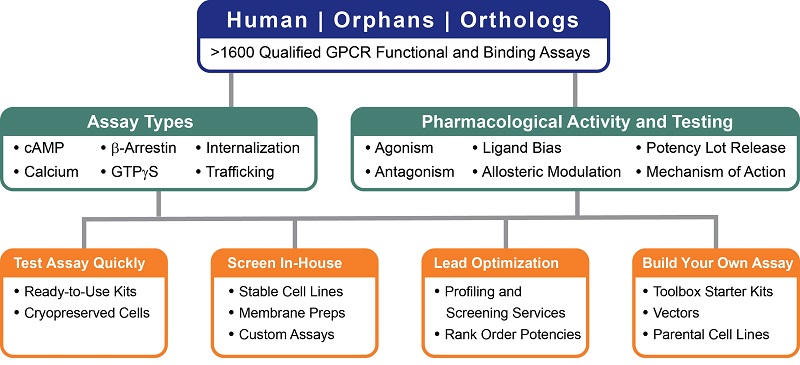
Highlights of GPCR Product Solutions
| Applications | Benefits | Product Portfolio | Credibility |
|---|---|---|---|
|
|
|
|
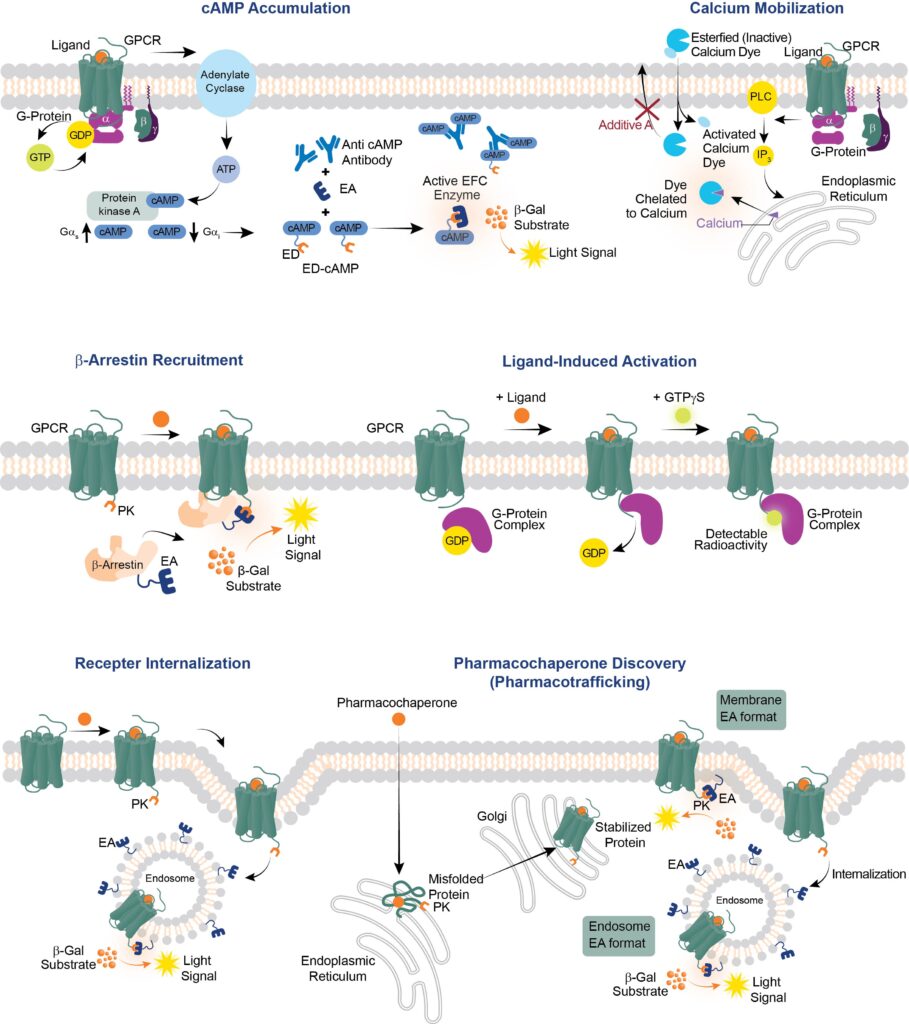
Whether you are developing small molecule or biologic therapeutic drugs, Eurofins DiscoverX provides you with a variety of drug discovery and development products with multiple assay types and applications to meet your specific GPCR research needs.
Access Products by Target Families
| Gene ID (Common) | Gene ID (Common) | Gene ID (Common) | Gene ID (Common) |
|---|---|---|---|
| 5-Hydroxytryptamine (Serotonin) | HTR1A (5HT1A) | Bombesin BRS3 | BRS3 (BB3) |
| HTR1B (5HT1B) | GRPR (BB2) | ||
| HTR1E (5HT1E) | NMBR (BB1) | ||
| HTR1F (5HT1F) | Bradykinin | BDKRB1 (B1) | |
| HTR2A (5HT2A) | BDKRB2 (B2) | ||
| HTR2B (5HT2B) | Calcitonin | CALCR (CT) | |
| HTR2C (5HT2C) | CALCR-RAMP1 (AMY1) | ||
| HTR5A (5HT5A) | CALCR-RAMP2 (AMY2) | ||
| HTR6 (5HT6) | CALCR-RAMP3 (AMY3) | ||
| HTR7A (5HT7A) | CALCRL-RAMP1 (CGRP1) | ||
| HTR7B (5HT7B) | CALCRL-RAMP2 (AM1) | ||
| HTR7D (5HT7D) | CALCRL-RAMP3 (AM2) | ||
| Acetylcholine (Muscarinic) | CHRM1 (M1) | Cannabinoid | CNR1 (CB1) |
| CHRM2 (M2) | CNR2 (CB2) | ||
| CHRM3 (M3) | Chemerin | CMKLR1 (ChemR23) | |
| CHRM4 (M4) | Chemokine | CCR1 | |
| CHRM5 (M5) | CCR2 | ||
| Adenosine | ADORA1 (A1) | CCR3 | |
| ADORA2A (A2A) | CCR4 | ||
| ADORA2B (A2B) | CCR5 | ||
| ADORA3 (A3) | CCR6 | ||
| Adrenoceptor | ADRA1A (a1A) | CCR7 | |
| ADRA1B (a1B) | CCR8 | ||
| ADRA1D (a1D) | CCR9 | ||
| ADRA2A (a2A) | CCR10 | ||
| ADRA2B (a2B) | CCRL1 | ||
| ADRA2C (a2C) | CX3CR1 | ||
| ADRB1 (b1AR) | CXCR1 (IL8RA) | ||
| ADRB2 (b2AR) | CXCR2 (IL8RB) | ||
| ADRB3 (b3AR) | CXCR3 | ||
| Angiotensin | AGTR1 (AT1) | CXCR4 | |
| Apelin | AGTRL1 (APJ) | CXCR5 | |
| Bile Acid (GPBA) | GPBAR1 (GPR131) | CXCR6 |
| Gene ID (Common) | Gene ID (Common) | Gene ID (Common) | Gene ID (Common) |
|---|---|---|---|
| Chemokine | CXCR7 (CMKOR1) | Glycoprotein Hormone | FSHR (FSH) |
| XCR1 (XC1) | LHCGR (LH) | ||
| Cholecystokinin | CCKAR (CCK1) | TSHR (TSH) | |
| CCKBR (CCK2) | Gonadotrophin-Releasing Hormone | GNRHR (GnRH) | |
| Complement Peptide (Anaphylatoxin) | C3AR1 (C3A) | Histamine | HRH1 (H1) |
| C5AR1 (C5A) | HRH2 (H2) | ||
| C5AR2 (C5L2/GPR77) | HRH3 (H3) | ||
| Corticotropin-Releasing Factor | CRHR1 (CRF1) | HRH4 (H4) | |
| CRHR2 (CRF2) | Hydroxycarboxylic Acid | HCAR1 (HCA1/GPR81) | |
| Dopamine | DRD1 (D1) | HCAR2 (HCA2/GPR109A/HM74A/NIC1) | |
| DRD2 (D2) | HCAR3 (HCA3/GPR109B/NIC2) | ||
| DRD3 (D3) | Kisspeptin | KISS1R (GPR54) | |
| DRD4 (D4) | Leukotriene | CYSLTR2 (LTC4) | |
| DRD5 (D5) | LTB4R (BLT1) | ||
| Endothelin | EDNRA (ETA) | OXER1 (GPR170) | |
| EDNRB (ETB) | Lysophospholipid (LPA & S1P) | LPAR1 (LPA1/EDG2) | |
| Formylpeptide | FPR1 (FPR) | LPAR2 (LPA2/EDG4) | |
| FPR2 (FPRL1/ALX) | LPAR3 (LPA3/EDG7) | ||
| FPR3 (FPRL2) | LPAR5 (LPA5/GPR92) | ||
| Free Fatty Acid | FFAR1 (FFA1/GPR40) | S1PR1 (S1P1/EDG1) | |
| FFAR2 (FFA2/GPR43) | S1PR2 (S1P2/EDG5) | ||
| FFAR3 (FFA3/GPR41) | S1PR3 (S1P3/EDG3) | ||
| FFAR4 (FFA4/GPR120) | S1PR4 (S1P4/EDG6) | ||
| Galanin | GALR1 (GAL1) | S1PR5 (S1P5/EDG8) | |
| GALR2 (GAL2) | Melanin-Concentrating Hormone | MCHR1 (MCH1) | |
| Ghrelin | GHSR (GRLN) | MCHR2 (MCH2) | |
| Glucagon | GCGR (Glucagon) | Melanocortin | MC1R (MC1) |
| GHRHR (GHRH) | MC3R (MC3) | ||
| GIPR (GIP) | MC4R (MC4) | ||
| GLP1R (GLP-1) | MC5R (MC5) | ||
| GLP2R (GLP-2) | Melatonin | MTNR1A (MT1) | |
| SCTR (Secretin) | MTNR1B (MT2) |
| Gene ID (Common) | Gene ID (Common) | Gene ID (Common) | Gene ID (Common) |
|---|---|---|---|
| Motilin | MLNR (Motilin) | Prostanoid | PTGER2 (EP2) |
| Neuromedin U | NMU1R (NMU1) | PTGER3 (EP3) | |
| Neuropeptide B & W | NPBWR1 (GPR7) | PTGER4 (EP4) | |
| NPBWR2 (GPR8) | PTGFR (FP) | ||
| Neuropeptide FF | NPFFR1 (GPR147) | PTGIR (IP) | |
| Neuropeptide S | NPSR1 (NPS) | TBXA2R (TP) | |
| Neuropeptide Y | NPY1R (Y1) | Proteinase-Activated | F2R (PAR1) |
| NPY2R (Y2) | F2RL1 (PAR2) | ||
| NPY4R (Y4/PPYR1) | F2RL3 (PAR4) | ||
| Neurotensin | Neurotensin | Relaxin Family Peptide | RXFP1 (LGR7) |
| Opioid | OPRD1 (δ) | RXFP2 (LGR8) | |
| OPRK1 (κ) | OPRK1 (κ) | RXFP3 (SALPR) | |
| OPRL1 (NOP) | RXFP4 | ||
| OPRM1 (μ) | Somatostatin | SSTR1 (SST1) | |
| Orexin | HCRTR1 (OX1) | SSTR2 (SST2) | |
| HCRTR2 (OX2) | SSTR3 (SST3) | ||
| Oxoglutarate | OXGR1 (GPR99/GPR80) | SSTR4 (SST4) | |
| P2Y P2RY1 (P2Y1) | SSTR5 (SST5) | ||
| P2RY2 (P2Y2) | Succinate | SUCNR1 (GPR91) | |
| P2RY4 (P2Y4) | Tachykinin | TACR1 (NK1) | |
| P2RY6 (P2Y6) | TACR2 (NK2) | ||
| P2RY11 (P2Y11) | TACR3 (NK3) | ||
| P2RY12 (P2Y12) | Thyrotropin-Releasing Hormone | TRHR (TRH1) | |
| Parathyroid Hormone | PTH1R (PTH1) | Trace Amine | TAAR1 (TA1) |
| PTH2R (PTH2) | Urotensin | UTS2R (UTR2) | |
| Peptide P518 | QRFPR (QRFP/GPR103) | Vasopressin & Oxytocin | AVPR1A (V1A) |
| Platelet-Activating Factor | PTAFR (PAF) | AVPR1B (V1B) | |
| Prokineticin | PROKR1 (PKR1/GPR73) | AVPR2 (V2) | |
| PROKR2 (PKR2) | OXTR (OT) | ||
| Prolactin-Releasing Peptide | PRLHR (PRRP) | VIP & PACAP | ADCYAP1R1 (PAC1) |
| Prostanoid | PTGDR (DP1) | VIPR1 (VPAC1) | |
| PTGDR2 (DP2/CRTH2) | VIPR2 (VPAC2) | ||
| PTGER1 (EP1) |
| Gene ID (Common) | Gene ID (Common) | Gene ID (Common) | Gene ID (Common) |
|---|---|---|---|
| BAI1 | GPR32 | GPR101 | GPR161 |
| BAI2 | GPR35 | GPR107 | GPR162 |
| BAI3 | GPR37 (Pael Receptor, EDNRBL) | GPR119 | GPR171 |
| CCRL2 | GPR37L1 | GPR123 | GPR173 (SREB3) |
| GHSR1b | GPR39 | GPR132 | GPR176 (HB954) |
| GPER (GPR30) | GPR45 (PSP24) | GPR135 (HUMNPIIY20) | GPR182 |
| GPR1 | GPR50 | GPR137 (TM7SF1) | GPR183 (EBI2) |
| GPR3 | GPR52 | GPR139 (PGR3) | LGR4 (GPR48) |
| GPR4 | GPR55 | GPR141 (AXOR115) | LGR5 (GPR49) |
| GPR6 | GPR61 | GPR142 (AXOR103) | LGR6 |
| GPR12 | GPR65 | GPR143 | MRGPRD |
| GPR17 | GPR68 | GPR146 (AXOR120) | MRGPRE |
| GPR18 | GPR75 | GPR148 | MRGPRF |
| GPR20 | GPR78 | GPR149 (R35, PGR10) | MRGPRX1 (MRGX1) |
| GPR22 | GPR79 | GPR15 (Bob) | MRGPRX2 (MRGX2) |
| GPR23 (LPA4, P2Y9) | GPR83 | GPR150 (AXOR70) | MRGPRX4 |
| GPR25 | GPR84 | GPR151 (AXOR40) | OPN5 |
| GPR26 | GPR85 (SREB2) | GPR152 | P2RY8 |
| GPR27 (SREB1) | GPR88 | GPR157 | TAAR5 |
| GPR31 | GPR97 |
An Application Note Assessing the Regulation of Mast Cell Function and its Implications in Safety Pharmacology. MrgprX2 antagonism promotes fresh…
Read MoreThrough early discovery, screening, characterization, and particularly for market release and commercialization of biologics, drug candidates require physiologically relevant, functional…
Read MoreAs more is learned about the intricacies of GPCR signaling, the harder it becomes to accurately describe ligand activity using…
Read MoreHere we show how PathHunter GPCR Internalization assays can be used to differentiate between strongly internalizing and weakly internalizing agonist…
Read MoreAs more is learned about the intricacies of GPCR signaling, the harder it becomes to accurately describe ligand activity using…
Read MoreWith a growing list of over 150 customer publications, PathHunter® Arrestin assays are among the most trusted functional GPCR assays…
Read MoreAs more is learned about the intricacies of GPCR signaling, the harder it becomes to accurately describe ligand activity using…
Read MoreGLP Cell Lines & Ready-to-Use Assays from Characterization through QC Lot Release
Read MoreFunctional Cell-Based Assays, Cell Lines, & Proteins for Cancer Research Improved or novel small molecule or biologic therapeutics for cancer…
Read MoreExplore GPCR-Ligand Interactions & Signaling Pathways with Binding & Functional Assays
Read MoreProducts & Custom Development Capabilities.
Read MoreAccelerate the Development of Peptide Therapeutics for Obesity & Diabetes With MOA-Reflective Assays — Assays for Screening, Profiling, Potency, &…
Read MoreYour source for a complete offering of GPCR assays, cell lines, and membrane preps
Read MoreTherapeutics targeting glucagon-like peptide, GLP-1 and GLP-2, receptors are being developed to address globally prevalent medical disorders for managing diabetes,…
Watch NowThe webinar addresses the challenge that much of the GPCR druggable space remains untapped for potential therapeutic targets. To address…
Watch NowGPCRs are privileged drug targets. Approximately 100 receptors still escape from the drug discovery process as they are orphans, without…
Watch NowOpioid receptors are among the most well-known GPCRs that regulate the transmission and perception of pain. Clinical management of severe…
Watch NowThis 30-minute webinar shows you how to make your own cell-based assays to analyze β-arrestin recruitment in any cell type.…
Watch NowThe screening and functional characterization of novel ligands for G-Protein Coupled Receptors (GPCR) remains a key focus in drug discovery.…
Watch NowLearn about several GPCR assays and which ones to use and why for your research and drug discovery and development…
Watch NowLearn about PathHunter Internalization assays developed to measure translocation of both single-pass and multi-pass receptors (like RTKs, checkpoint receptors and…
Watch NowLearn about PathHunter pharmacotrafficking assays to identify small molecule compounds that rescue disease relevant mutant membrane proteins like GPCRs, ion…
Watch NowLearn about Eurofins DiscoverX cell line engineering, assay development, and recombinant enzyme production custom capabilities. Find out more about cell…
Watch NowWith more than 25% of the world’s population diagnosed with type II diabetes and/or metabolic syndrome, the requirement for cost…
Read MoreDiscoveRx offers an industry-leading portfolio of over 600 naturally coupled human and ortholog G-protein coupled receptor (GPCR) cell lines designed…
Read MoreThe screening and functional characterization of novel ligands for G-protein-coupled receptors (GPCRs) remains a key activity in drug discovery process.…
Read MoreDiscoveRx has developed a novel application of our established Enzyme Fragment Complementation (EFC) technology that allows us to monitor protein-protein…
Read MoreGPCR activation results in G-protein dependent events such as second messenger signaling, as well as initiation of a host of…
Read MoreThe pattern of intracellular signaling downstream of GPCR activation is now known to be specific to the ligand-receptor pair as…
Read MoreDiscoveRx has developed a panel of over 30 naturally Gq-coupled or dual coupled GPCR/Arrestin cell lines that can be used…
Read MoreNeutralizing antibodies (NAbs) to biological drugs may cause loss of therapeutic effi cacy and in some cases, loss of endogenous…
Read MoreThe cAMP detection technologies are widely used in high throughput screening (HTS) for measuring a functional response of a GPCR…
Read MoreCompounds that bind to allosteric sites offer many benefits over those which interact orthosterically. These include enhanced specificity, ability to…
Read MoreMast cells are principal players in IgE-, and more recently, non-IgE-mediated anaphylactoid reactions or pseudo-allergic Adverse Drug Reactions (ADR). A…
Read MoreThe recent appreciation of functional selectivity/ligand bias in GPCR signaling has uncovered new opportunities for therapeutic discovery and continues to…
Read MoreDiscoveRx® has pioneered a novel enzyme complementation system to monitor cellular events such as protein translocation, protein interactions, and degradation…
Read MoreDiscoveRx® has pioneered a novel enzyme complementation system to monitor cellular events such as protein translocation, protein interactions, and degradation…
Read MoreDiscoveRx has pioneered a novel enzyme complementation system to monitor cellular events such as protein translocation, protein interactions, and degradation…
Read MoreOrphan GPCRs continue to represent a target class with immense potential for the discovery of novel therapeutic compounds. In spite…
Read MoreDiscoveRx previously introduced a protein-protein interaction system using enzyme fragment complementation that provides a robust, HTS friendly format for monitoring…
Read MoreInterest in GPCR ligand bias has increased in recent years due to evidence that positive and negative aspects of drug…
Read MoreA common feature of 7TM receptors is that upon activation, the receptors are bound by cellular Arrestin proteins. DiscoveRx has…
Read MoreDiscoveRx has developed a panel of over 120 characterized GPCR cell lines that monitor receptor activity using interaction with human…
Read MoreThere is an increasing need to generate therapeutics targeting metabolic and gastrointestinal diseases to address the global burden of metabolic…
Read MoreDiscoveRx’s PathHunter® platform is a simple, cell-based, chemiluminescent assay format that allows for screening large numbers of small molecules or…
Read MoreBoth multi- and single-pass membrane receptors constitutively exhibit complicated and dynamic membrane receptor trafficking as well as internalization induced by…
Read MoreGlucagon-like peptides, GLP-1 & GLP-2, are well-researched, metabolically significant peptide hormones secreted from the L-cells of the small intestine in…
Read MoreGPCRs have long been regarded as a low-hanging fruit drug target as they are conveniently located on the cell surface…
Read MoreDrugs interact with living physiology; an in vitro assay of drug activity can be considered a snapshot of the full…
Read MoreGlucagon-Like Peptide-1 (GLP-1), a member of the glucagon-secretin peptide family, is secreted from L-cells of the small intestine and binds…
Read MoreExplore GPCR-Ligand Interactions & Signaling Pathways with Binding & Functional Assays
Read MoreImportance in Drug Discovery & Development for Quality Testing Programs. GPCR CNR1 Bioassay example.
Read MoreCellular membrane proteins play important functions in many biological processes. Understanding their roles often requires that these proteins be isolated…
Read MoreCell-based assays are useful for understanding cellular pathways; characterizing targets and their function; identifying, screening, and optimizing ligands or drugs…
Read MorePresenting a compelling narrative on the pharmacological characterization of the MRGX2 gene. Dr. Brown emphasized the receptor’s importance as a…
Read MoreMost GPCRs are pleiotropically coupled to multiple signaling pathways in cells and the availability of functional assays to separately measure…
Read MoreTranslocation and Trafficking of Membrane Proteins
Read MoreArrestins are ubiquitously expressed and function in the activation of GPCRs, desensitization of most 7-transmembrane receptors (7-TMs), and regulation of…
Read MoreLigand bias is the ability of compounds to exert differential signal transduction responses on activation of a GPCR. This is…
Read MoreApplication of GPCR Pharmacotrafficking & Cell-Based Assays
Read MoreThe β2-adrenergic receptor (β2AR) has been a model system for understanding regulatory mechanisms of G-protein-coupled receptor (GPCR) actions and plays…
Read MoreExtensive 3′ alternative splicing of the mu opioid receptor gene OPRM1 creates multiple C-terminal splice variants. However, their behavioral relevance…
Read Moreβ-Arrestins (βarrs) interact with G protein-coupled receptors (GPCRs) to desensitize G protein signaling, to initiate signaling on their own, and…
Read MoreEndogenous mechanisms that orchestrate resolution of acute inflammation are essential in host defense and the return to homeostasis. Resolvin (Rv)D2…
Read MoreWith the hope of discovering effective analgesics with fewer side effects, attention has recently shifted to allosteric modulators of the…
Read Moreβ-Arrestins are ubiquitously expressed in all cell types, and function in the desensitization of G- protein coupled receptors (GPCRs), the…
Read MoreThis article describes the finding of substantial upregulation of mRNA and enzymes of the cytochrome P450 1A family during a…
Read MoreThe glucagon-like peptide-1 receptor (GLP-1R) is an important physiologic regulator of insulin secretion and a major therapeutic target for diabetes…
Read MoreUnderstanding the function of orphan G protein-coupled receptors (GPCRs), whose cognate ligand is unknown, is of major importance as GPCRs…
Read MoreMast cells play key roles in allergy, anaphylaxis/anaphylactoid reactions, and defense against pathogens/toxins. These cells contain cytoplasmic granules with a…
Read MoreG-protein-coupled receptors (GPCRs) have varying and diverse physiological roles, transmitting signals from a range of stimuli, including light, chemicals, peptides,…
Read MoreG-protein-coupled receptors (GPCRs) have varying and diverse physiological roles, transmitting signals from a range of stimuli, including light, chemicals, peptides,…
Read MoreType 2 diabetes (T2D) affects Latinos at twice the rate seen in populations of European descent. We recently identified a…
Read MoreThe MAS-related Gq protein-coupled receptor X4 (MRGPRX4) is poorly investigated. MRGPRX4 has been proposed to be involved in pain transmission,…
Read MoreThere are at least three unique features of allosteric ligand-receptor interactions that lead to potentially valuable therapeutic behaviors…
Read MoreExplore Functional Systems Driving GPCRs to the Forefront of Focused & Safe Therapeutics. Gain insights from industry experts on GPCR…
Read More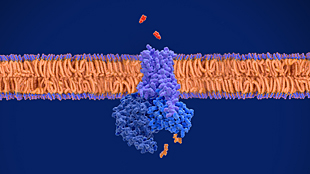
Universal G-protein independent cell-based assays to quantify GPCR activation based on the recruitment of β-arrestin
Read More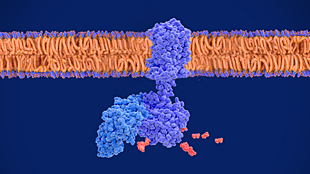
Accurately monitor GPCR activation by biologics or small molecules & detect cellular cAMP production levels for a variety of applications
Read More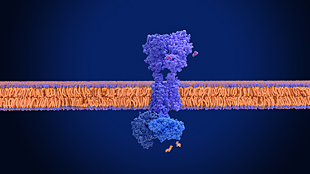
Fluorescent assays to measure calcium mobilization in cell lines as a direct indication of GPCR or ion channel activation or…
Read More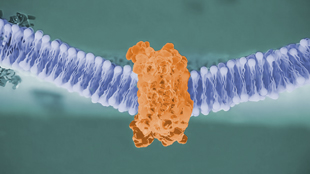
Screening cell-based assays for analyzing the movement of proteins to multiple membrane compartments within the cell
Read More
Quantitative cell-based assays to identify pharmacochaperones that stabilize & correct disease-relevant mutant GPCRs, ion channels, or transporters
Read More
Complete set of parental cell lines, vectors, kits, & retroparticles to build your own stable cell lines & cell-based assays
Read More
Custom cell lines, kits, assays, & protein development capabilities optimized to fit your requirements
Read More
Non-imaging, cell-based internalization assays for screening & identifying safer drugs for GPCRs
Read More
Purified GPCR & ion channel membrane preps for binding & functional analysis
Read More
